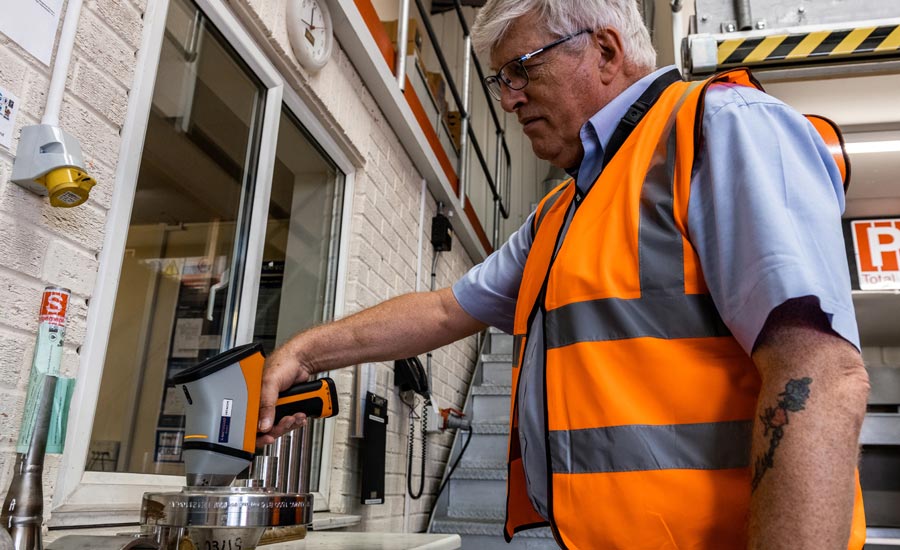The COVID-19 pandemic has disrupted our daily lives on an unprecedented global scale. The need to alter our way of life to try to mitigate and contain the virus has made us press pause on everything we take for granted, from visiting family and friends to travelling to work and business continuity.
In manufacturing, global supply chains have been disrupted in a way never seen before. As businesses flex to accommodate the dramatically different demand and working conditions, many are having to rapidly bring on board new suppliers to feed their production lines or adapt to market needs by producing new products like ventilators for hospitals. These disruptions and rapid shifts have impacted quality control processes.
In the current circumstances, minimizing your risk and ensuring that the wrong material does not accidentally find its way into products in a busy manufacturing facility is crucial. Having the right incoming inspection processes in place for raw materials and components will help to avoid wasting money and time on reworking, interruptions to production and scrapping material. In the long run, manufacturers will want to avoid the cost of customer returns and potential loss of contracts, which damage the bottom line and reputation.
The response of manufacturing to supply disruption
In the short-term, manufacturers simply need to survive, with a focus on damage limitation, before carefully planning the route back to business as usual. Ultimately, this will need to be done as fast as possible and at the lowest cost.
After having faced the reality of how fragile global supply chains are, many manufacturers may aim for a new normal, restructuring supply chains to source parts from a more diverse set of suppliers. As manufacturers rebuild, they’ll have a keen eye on cost. Waste and rework must be minimized, so ‘right first time’ and ‘zero defect’ strategies will be more important than ever.
Material analysis plays a crucial role in manufacturing rebuild
In a nutshell, the more testing of raw materials or components that can be fitted in, the more freedom there will be to source materials, as you’ll be able to test everything before it hits production.
1. If production was halted completely
The first job is to take stock of everything.
But before this is done, if valuable analytical instruments have been switched off for a few weeks, steps need to be taken to ensure optimum instrument performance as operations are ramped up. Get in touch with the manufacturer for any product specific instructions they may have; they’ll be able to provide guidance if they haven’t done so already.
Sharp ramp-ups and production re-starts are notorious for material-mix ups and wrong parts ending up in finished products. Materials analysis, such as XRF (X-ray fluorescence) or LIBS (laser induced breakdown spectroscopy), can help to swiftly identify the material in stock and work in progress. Finished goods can be double-checked to ensure companies do not need to compensate a customer for the wrong part being used in their production. Internal rework can be vastly reduced simply by making sure the right metal grade and specification is used for the right product.
If faced with having to switch suppliers as your current supply chain is not delivering yet, companies will also need to check raw material and components coming in. Again, analytical techniques, such as XRF, LIBS or even mobile spark OES (optical emission spectrometer), can help to verify the composition of everything from stainless steel to petroleum. This type of analysis is fast and means material from a new supplier can be used almost immediately or rejected straightaway. This will help with your cash flow, as well as meeting on-time delivery, as there won’t be unverified material sitting in stock.
2. If production is ongoing but switching suppliers
There have been many stories, especially with PPE equipment, where companies have had to switch suppliers on the fly to ensure they meet demand but have found that the products delivered were far from meeting specification. In manufacturing or fabrication, it’s relatively straightforward to introduce steps to control your own processes, but being part of a supply chain, any errors made by suppliers could result in costly quality problems unless action is taken to verify incoming material.
If we apply this to raw material or metal components, material properties become crucial. Using the right grade of base material, like stainless steel, is essential to ensure the finished component has the right level of corrosion resistance, for example. It’s impossible to tell the difference between, say, 304 and 304L grade steel by simply looking at it. Being absolutely sure you’re using the right grade of material is as easy as carrying out a simple check with an analyzer, which takes seconds.
There are times as well when there will be a need to be able to analyze all alloying, treatment, trace, residual and tramp elements especially in steel, iron and aluminum applications. Mobile spark OES analyzers can detect very low limits of most trace elements, including carbon in L-grade steels. Spark OES can be used to measure other trace elements too, such as boron, nitrogen, sulfur and phosphorous.
With many different grades of cast iron, steel and aluminum, quick analysis will help to ensure raw material or components meet the specifications of the alloy grade.

Being absolutely sure you’re using the right grade of material is as easy as carrying out a simple check with an analyzer.
The analyzer you use makes all the difference
In-house analysis means holding all the cards when it comes to material verification and having the freedom to try and accept or reject new suppliers. However, the analyzer itself needs to have some specific features to be able to do the job:
- Efficiency: When testing a lot of material aiming for 100% PMI (positive material identification), a fast and efficient analyzer that’s portable will enable the testing of hundreds of components in a single day.
- Low cost of ownership: Given current circumstances, cash flow is a highly scrutinized asset. The analyzer should pay for itself and be cost-effective to operate.
- Reliable and accurate: With right first-time production techniques in place, it is crucial that your analyzer is reliable and gives results that can be trusted time after time.
- Data management: With vast amounts of test data being produced, the instrument needs to be able to capture, store and transfer information for easy reference and real-time decision making.
- Robust service agreement: It’s not always just about the analyzer itself. Fast, cost-effective support when needed helps to keep production running.
Conclusion
Thanks to the continued development of material analysis technologies like LIBS, OES and XRF, testing in-house couldn’t be easier. In current times, it’s particularly important to ensure at the incoming inspection stage that the right quality control processes are in place. Material mix-ups, mixed-up or even forged certificates, and lost certificates and stamps, however, are an unfortunate reality in manufacturing operations. A simple incoming inspection check really should not be the first stumbling block to ensure a successful recovery from COVID-19, and with investments in material analysis technologies, you can be prepared for any changing circumstances. NDT



